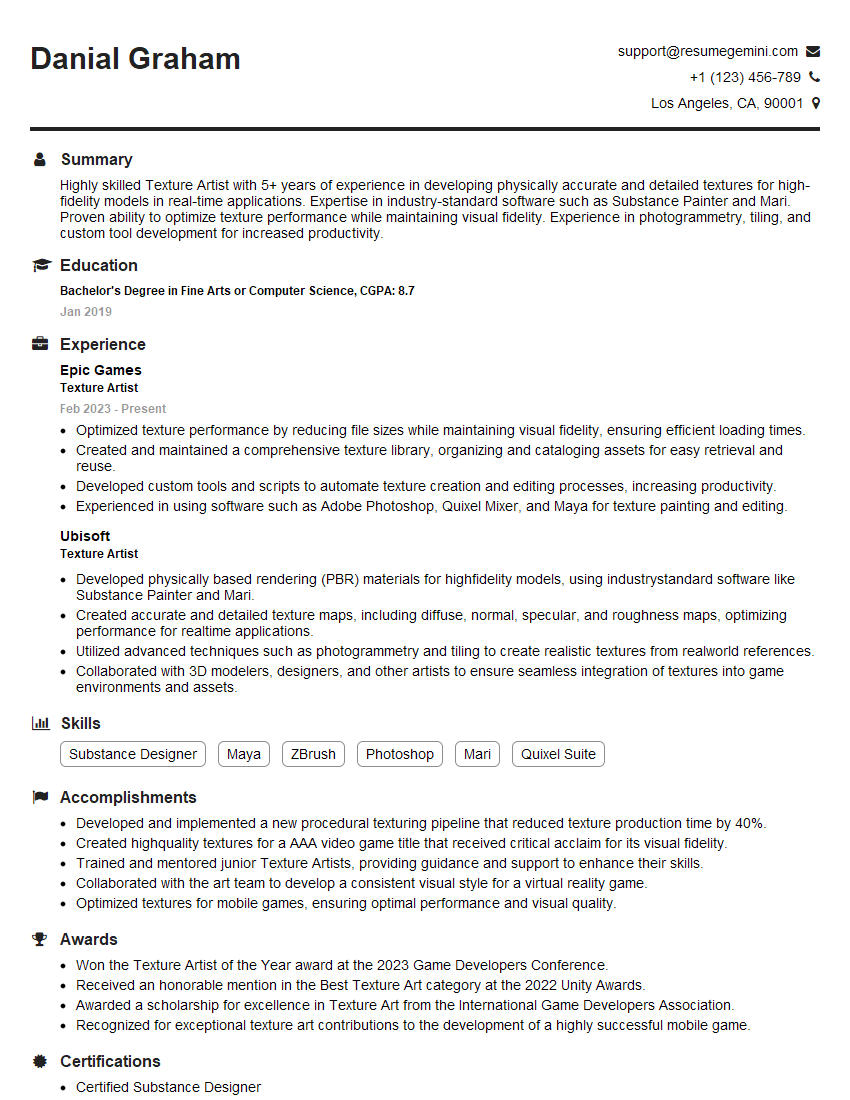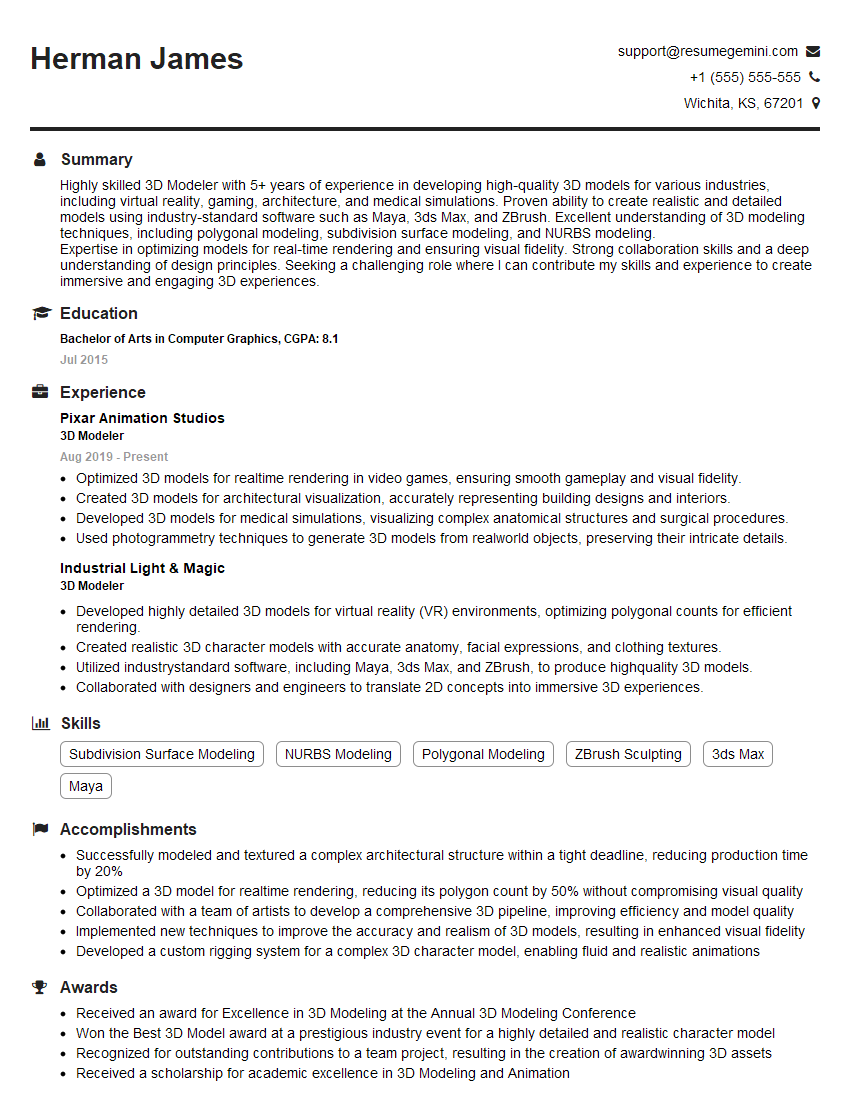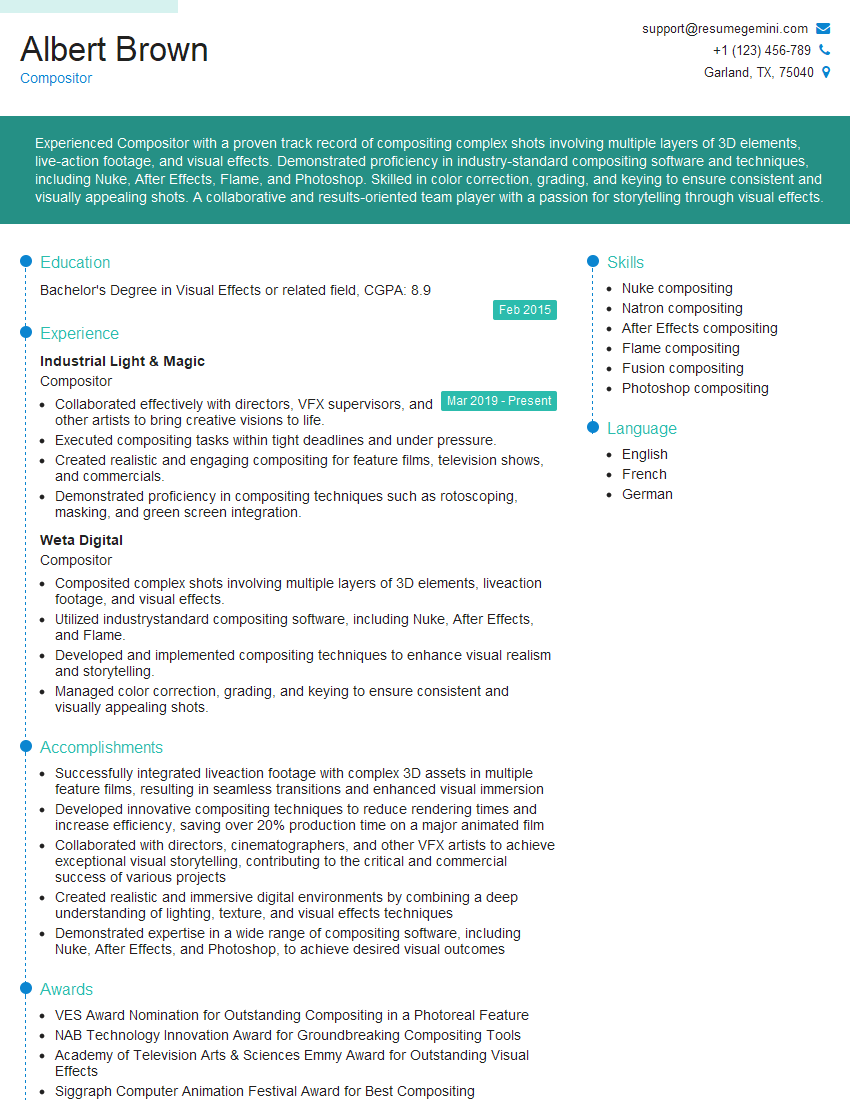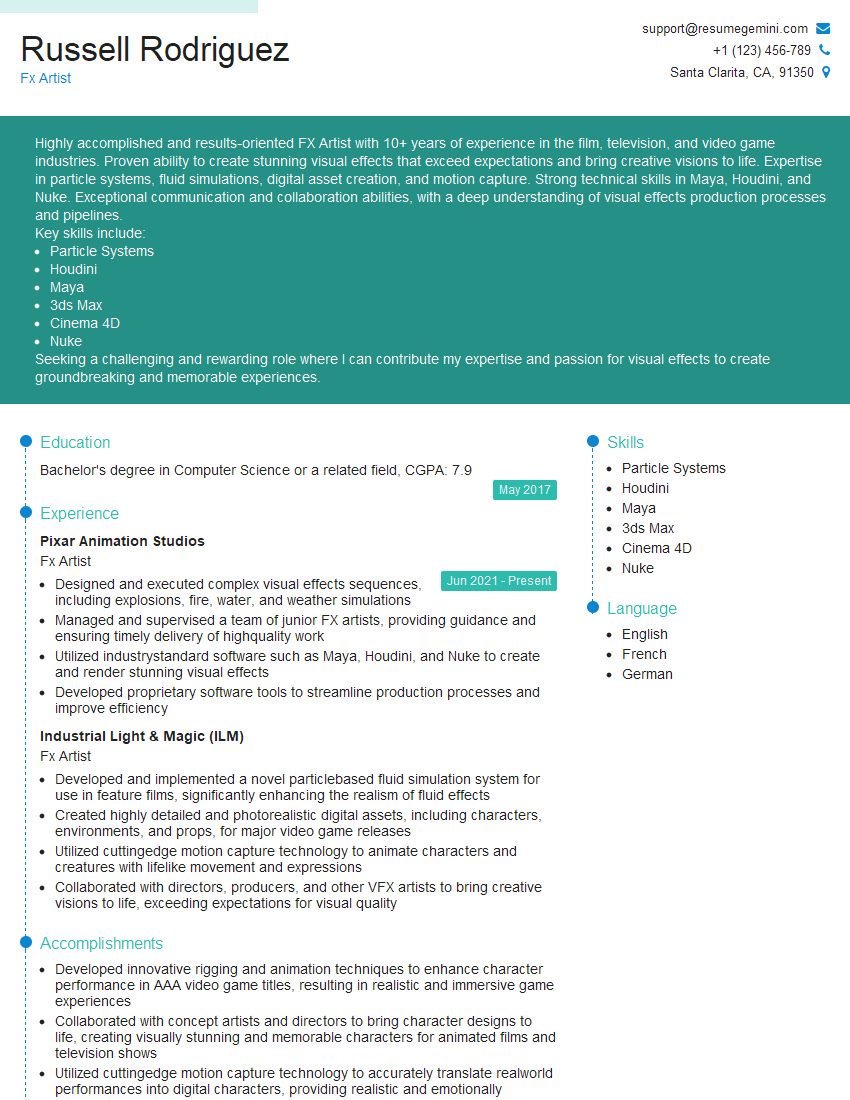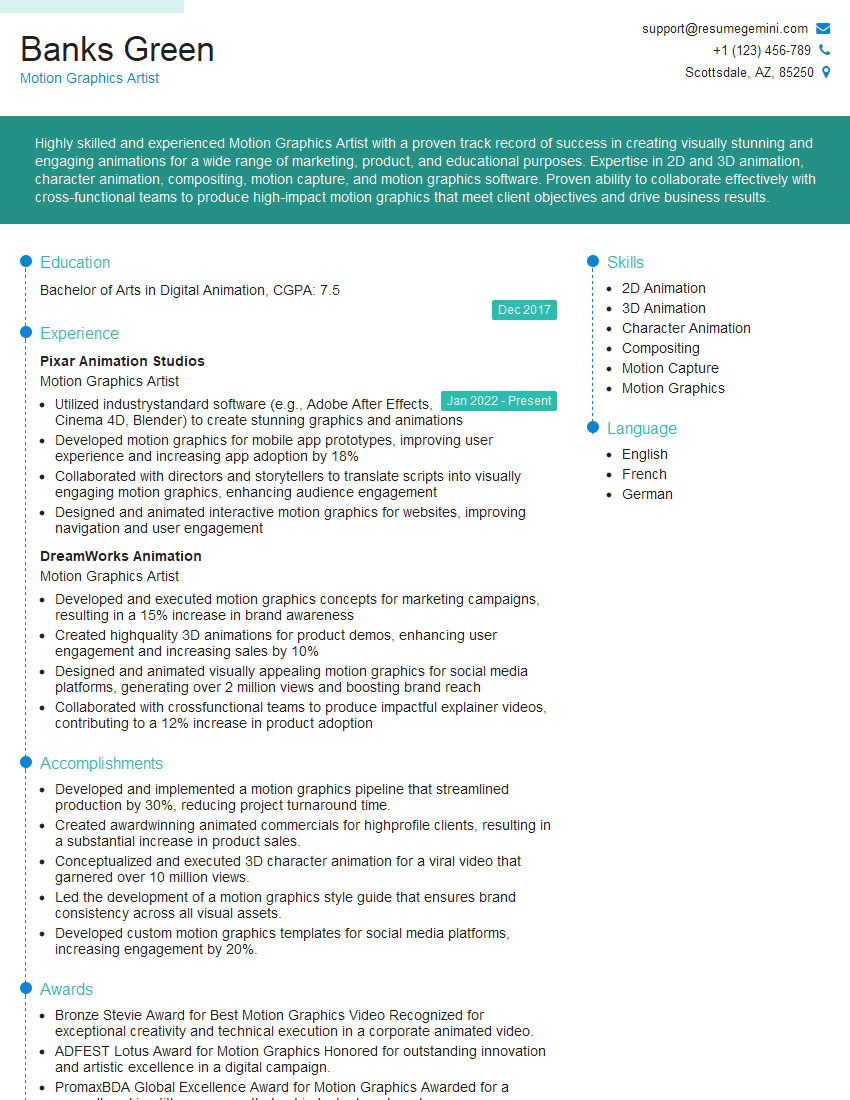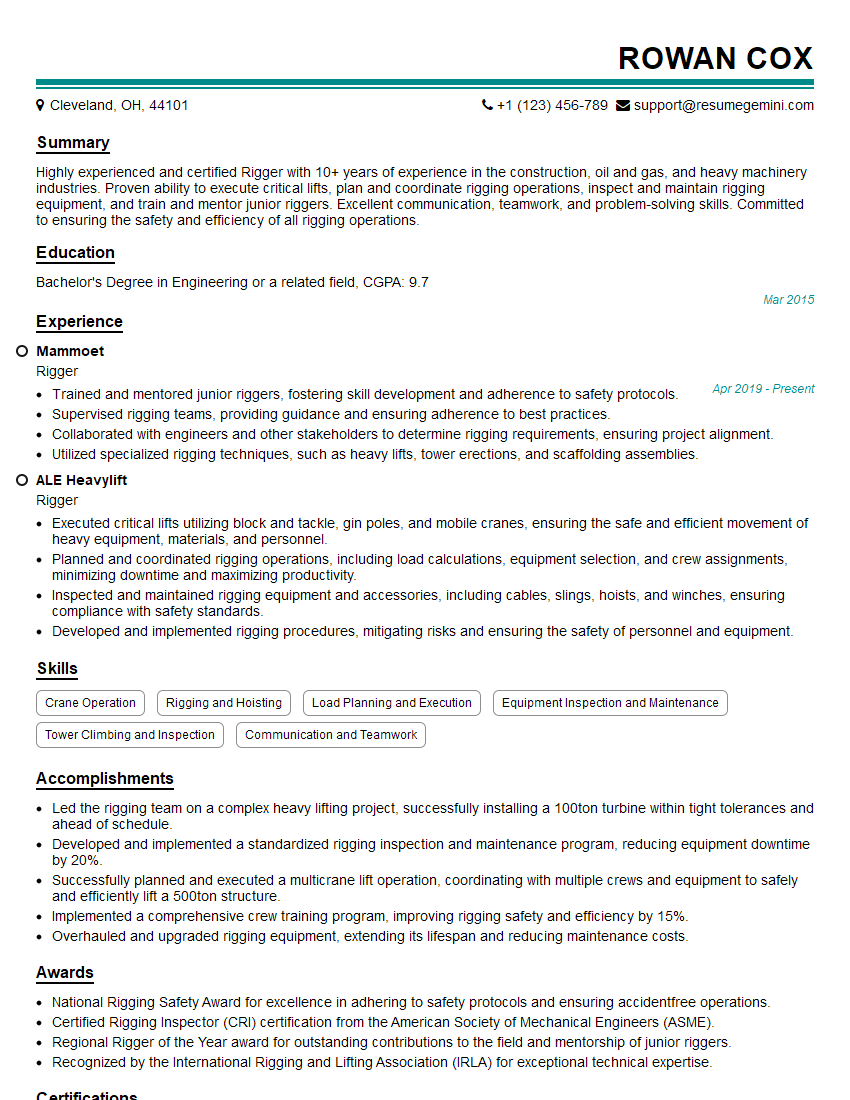Unlock your full potential by mastering the most common CGI Modeling and Animation interview questions. This blog offers a deep dive into the critical topics, ensuring you’re not only prepared to answer but to excel. With these insights, you’ll approach your interview with clarity and confidence.
Questions Asked in CGI Modeling and Animation Interview
Q 1. Explain your experience with various 3D modeling software (e.g., Maya, 3ds Max, Blender).
My experience spans a wide range of 3D modeling software, including industry-standard packages like Autodesk Maya, 3ds Max, and the open-source powerhouse Blender. Each has its strengths. Maya, for instance, excels in character animation and its robust toolset for complex rigs. 3ds Max shines in architectural visualization and its powerful modeling capabilities, particularly for hard-surface modeling. Blender, with its constantly evolving feature set and free accessibility, is a fantastic tool for everything from quick prototyping to high-end production, offering a cost-effective alternative to commercial software.
I’ve used Maya extensively for projects involving character animation and complex environments. Its sculpting tools, combined with its robust animation system, make it ideal for creating believable characters and animations. In contrast, I’ve leveraged 3ds Max’s strengths in architectural visualization for projects involving building models and interior design. My experience with Blender has been invaluable for personal projects and rapid prototyping, allowing me to experiment with different modeling techniques without the constraints of licensing costs. This diverse experience allows me to adapt to different production pipelines and client preferences with ease.
Q 2. Describe your workflow for creating a realistic human character model.
Creating a realistic human character model is a multi-step process that requires meticulous attention to detail. My workflow typically begins with concept art or reference images to establish the character’s anatomy, features, and clothing. I then utilize a combination of modeling techniques, including:
- Base Mesh: I start by creating a simplified base mesh, often using a combination of polygon modeling and sculpting in ZBrush or similar software. This establishes the overall form and proportions.
- High-Poly Detailing: Next, I sculpt high-resolution details into the base mesh, focusing on accurate anatomy, wrinkles, pores, and subtle surface variations. This stage is crucial for photorealism.
- Retopology: I then retopologize the high-poly model, creating a clean, low-poly mesh that is optimized for animation and texturing. This involves creating a new, efficient mesh that accurately follows the form of the high-poly model.
- UV Unwrapping: Proper UV unwrapping is essential for efficient and distortion-free texture application. I carefully plan UV layouts to minimize seams and ensure even texture distribution.
This layered approach ensures the model is both visually appealing and performant for animation. Think of it like building a house: you start with a basic structure (base mesh), add intricate details (high-poly), then refine it for practicality (retopology) before adding the finishing touches (texturing).
Q 3. How do you approach texturing and shading to achieve photorealism?
Achieving photorealism in texturing and shading requires a deep understanding of materials and light interaction. My approach centers around several key aspects:
- Reference Gathering: I begin by gathering high-quality reference images of real-world materials, meticulously studying their color variations, subsurface scattering, and reflectivity.
- Texture Creation: I create textures using a combination of techniques, including procedural generation, photogrammetry, and hand-painting. I frequently use Substance Painter or Mari for this.
- Shader Networks: I use sophisticated shader networks to simulate the complex behavior of light interacting with different materials. This involves adjusting parameters like roughness, specular highlights, subsurface scattering, and normal maps to precisely match the reference images.
- Layered Approach: I employ a layered approach to texture and shading, creating base colors, subtle variations, and highlights to build depth and realism. For example, I might layer a diffuse texture with normal, roughness, and specular maps to achieve a detailed and believable surface.
The key to achieving photorealism is not just creating realistic textures but also understanding how light interacts with those textures and the overall scene. For example, subtle changes in subsurface scattering can significantly impact the realism of skin.
Q 4. What are your preferred methods for rigging and skinning characters?
My preferred methods for rigging and skinning characters focus on creating rigs that are both robust and efficient. I usually start by creating a skeleton that accurately represents the character’s bone structure. This is then carefully bound to the character mesh using skinning techniques. I frequently utilize:
- Inverse Kinematics (IK): I use IK extensively to control limbs and other articulated parts of the character, allowing for intuitive and natural posing.
- Forward Kinematics (FK): I combine IK with FK, depending on the character’s needs. FK provides more direct control over individual joints when needed, often in combination with IK for more complex movements.
- Advanced Rigging Techniques: For complex characters, I often employ advanced rigging techniques such as stretchy limbs, blend shapes, and expressions to achieve realistic deformations and facial animations.
The goal is to create a rig that allows animators to easily and efficiently pose and animate the character, resulting in fluid, realistic movements. A well-built rig is like a well-oiled machine – it ensures a smooth animation process.
Q 5. Explain your experience with animation principles (e.g., squash and stretch, anticipation).
Animation principles, such as squash and stretch, anticipation, and follow-through, are fundamental to creating believable and engaging animation. My understanding and application of these principles are essential to my work.
- Squash and Stretch: I use squash and stretch to emphasize weight, volume, and the impact of forces on a character. This adds a sense of dynamism and realism to movements, making them more believable and less stiff.
- Anticipation: Anticipation is crucial for preparing the audience for an action. It helps make movements feel natural and less abrupt. For example, before a character jumps, they might crouch slightly to build up momentum.
- Follow-Through and Overlapping Action: These principles add a natural flow to movement. Follow-through involves parts of the character continuing to move after the primary action has stopped (like hair or clothing). Overlapping action creates more fluid motion.
I constantly refer to the work of animation pioneers like Disney to refine my application of these principles. Mastering them is a continuous process of observation and experimentation. Understanding these principles allows me to create believable and expressive character animations.
Q 6. Describe your process for creating realistic cloth or hair simulations.
Creating realistic cloth or hair simulations often involves using specialized simulation software or plugins within my main 3D application. My process involves:
- Mesh Preparation: I begin by carefully modeling the cloth or hair mesh, ensuring it is properly subdivided and has appropriate topology for simulation.
- Simulation Setup: I configure the simulation parameters, such as gravity, stiffness, and drag, depending on the desired realism. This often involves experimentation and tweaking.
- Solver Selection: I choose appropriate solvers based on the complexity and requirements of the simulation, carefully balancing realism and simulation time. Ncloth in Maya or similar tools in other applications are often used.
- Cache Management: Large simulations can be computationally expensive. I utilize caching techniques to manage memory and speed up rendering times.
Simulating realistic cloth and hair requires a blend of artistic judgment and technical expertise. While software helps generate the simulation, artist intervention is often crucial for achieving believable results, requiring careful adjustment of parameters and often manual tweaking of the simulation results.
Q 7. How do you handle complex lighting setups in your scenes?
Handling complex lighting setups requires a strategic approach and a strong understanding of lighting principles. My process typically involves:
- Reference Images: I begin by collecting reference images that illustrate the desired lighting style and mood. This helps me visualize the overall lighting scheme.
- Light Types: I utilize a variety of light types (point lights, directional lights, area lights, etc.) to achieve a realistic and nuanced lighting environment. The choice of light type depends heavily on the desired effect.
- Global Illumination: I leverage global illumination techniques like ray tracing or path tracing to accurately simulate the indirect lighting within the scene. This adds realism and subtlety to the scene.
- Light Linking: For complex scenes, I utilize light linking techniques to optimize rendering times while maintaining visual fidelity. This involves carefully considering the interaction of lights within the scene.
- HDRI Environments: I frequently use HDRI (High Dynamic Range Image) environments to provide realistic lighting and reflections within the scene.
Lighting is crucial in establishing the mood and atmosphere of a scene, and creating a believable environment requires a deep understanding of both technical aspects of lighting and artistic principles of composition. It’s an iterative process, constantly evaluating and adjusting parameters to refine the overall aesthetic.
Q 8. What are your preferred compositing techniques?
My preferred compositing techniques revolve around a layered approach, prioritizing efficiency and flexibility. I start with a solid understanding of the final shot’s requirements, determining which elements need to be composited and how they interact. This informs my choice of compositing software, often Nuke or After Effects, depending on the project’s complexity and scale. For example, in a recent project involving a spaceship flying through a nebula, I used Nuke’s powerful node-based system to layer the spaceship render, pre-rendered nebula background plates, and added particle effects for atmospheric dust and lens flares. This allowed for non-destructive editing and easy adjustment of elements throughout the post-production process. I extensively use roto-masking and keying techniques to isolate and combine elements seamlessly, often employing techniques like color correction, spill suppression, and edge feathering to create a realistic and visually cohesive result. The key is to keep the process organized, using masks and groups effectively to prevent visual artifacts and make the composite easily manageable.
Q 9. Explain your understanding of different render engines (e.g., Arnold, V-Ray, RenderMan).
My experience spans several leading render engines, each with its strengths and weaknesses. Arnold is known for its excellent subsurface scattering capabilities, making it ideal for realistic skin and organic materials. I’ve used it extensively for projects requiring photorealistic rendering, benefiting from its speed and robust features, particularly its physically-based rendering (PBR) workflows. V-Ray, on the other hand, offers unparalleled versatility, excelling in architectural visualization and product rendering due to its robust material system and efficient handling of complex scenes. I’ve used V-Ray’s interactive rendering features for quick iterations and feedback during the creative process. RenderMan is a powerhouse renowned for its highly realistic results and sophisticated lighting and shading models. It’s perfect for projects demanding the utmost realism, though it requires a steeper learning curve and may be less efficient than Arnold or V-Ray for very large scenes. I chose RenderMan for a recent project depicting a highly detailed space station, leveraging its capabilities for handling complex geometry and subtle lighting interactions.
Q 10. How do you optimize your models and scenes for efficient rendering?
Optimizing models and scenes for rendering is crucial for managing time and resources. My strategy involves a multi-pronged approach. First, I focus on model optimization. This means using efficient polygon counts, avoiding unnecessary geometry, and employing level of detail (LOD) techniques to reduce the number of polygons rendered at different distances from the camera. For example, in a large outdoor scene, distant trees might be represented with low-poly models while close-up trees use highly detailed models. Second, I optimize the scene itself. This includes using proxies for complex objects during initial rendering tests and optimizing lighting and shadow settings. Unnecessary lights and complex shadow calculations can significantly increase render times. I meticulously utilize instancing and other scene management techniques whenever possible. Finally, I leverage render engine-specific optimization techniques. This might involve adjusting ray tracing settings, using appropriate sampling methods, or employing features like denoising to reduce render times without compromising quality. Using render layers also allows for selective rendering of different scene components, optimizing individual parts to their appropriate level of detail.
Q 11. Describe your experience working with motion capture data.
I have significant experience working with motion capture (MoCap) data. My workflow typically begins with cleaning and preprocessing the raw MoCap data using software like MotionBuilder or Maya’s Motion Capture tools. This involves removing noise, fixing any inconsistencies, and retargeting the animation to different character rigs. I pay close attention to the nuances of the performance, working to retain the emotional expression and subtle movements while making the animation work within the context of the scene. A recent project involved using MoCap data for a character performing parkour. The raw data needed significant cleanup to smooth out jerky movements and to adapt it to our character rig, which had different proportions than the MoCap actor. After cleaning, I used editing tools to refine the animation, adding secondary actions and adjusting timing to match the desired visual style. Finally, I seamlessly integrated the MoCap data with other animation techniques to bring the character to life.
Q 12. Explain your understanding of different animation styles (e.g., realistic, stylized, cartoon).
Different animation styles require distinct approaches. Realistic animation strives for accuracy and believability, adhering to the laws of physics and human anatomy. I accomplish this through careful study of reference material and detailed attention to weight and motion. Stylized animation prioritizes artistic expression over strict realism. It often features exaggerated movements and unique character designs. Cartoon animation takes this further, employing simplified forms and exaggerated expressions for comedic or dramatic effect. My approach changes according to the style. For realistic animation, I emphasize subtle nuances and natural movement. For stylized animation, I focus on expressive posing and keyframes. And in cartoon animation, I prioritize clarity and visual impact, often using squash and stretch techniques to enhance the character’s personality.
Q 13. How do you troubleshoot technical issues during the animation process?
Troubleshooting is an integral part of the animation process. My approach involves a systematic investigation. First, I carefully examine the error message or symptoms. If the issue is related to rendering, I check the render settings, scene complexity, and any potential issues with the models or textures. I use the render engine’s debugging tools and diagnostic outputs to pinpoint the source of the problem. Secondly, if it’s animation-related, I inspect the animation curves, searching for inconsistencies or unexpected keyframes. I also verify the character rig’s integrity and the correctness of constraints and weight painting. If the problem involves software, I consult online resources and the software’s documentation. I’ll often revert to previous versions of my work if I encounter a critical issue to ensure that I don’t inadvertently lose progress or introduce new errors. Finally, I document all solutions and troubleshooting steps to prevent future occurrences of similar problems. I find that working systematically, maintaining detailed notes, and relying on established debugging workflows is crucial for efficient problem-solving.
Q 14. Describe your experience with version control systems (e.g., Perforce, Git).
I have extensive experience using Perforce and Git for version control, choosing the system best suited to the project’s requirements. Perforce is my preferred system for large-scale projects with many users and large files (like those common in CGI work), as it offers robust features and strong performance in handling large binaries. Git is valuable for smaller projects and tasks where speed and flexibility are paramount. I regularly use branching strategies to manage different versions of assets and shots, facilitating collaborative work without conflicts. My typical workflow involves committing regular changes with descriptive commit messages and employing pull requests to review and integrate code. I am proficient in using both command-line and graphical user interfaces for these systems and consistently maintain a well-organized and properly versioned project repository, which is invaluable for collaboration and for tracking modifications throughout the project lifecycle.
Q 15. Explain your experience with collaborative workflows in a team environment.
Collaborative workflows are essential in CGI, especially in large-scale productions. My experience involves leveraging various software and communication tools to ensure seamless teamwork. I’ve worked extensively with teams using platforms like Shotgun, which helps manage assets, track revisions, and facilitate communication. We utilize cloud-based storage for easy access and version control. For example, on a recent project involving a complex animated sequence, our team—comprising modelers, animators, riggers, texture artists, and lighting technicians—used Shotgun to assign tasks, track progress, and review each other’s work. This prevented bottlenecks and ensured consistency in the final product. I am proficient in clearly communicating technical details and providing constructive feedback to colleagues, ensuring everyone is on the same page regarding project goals and creative vision. We frequently hold review sessions, utilizing the software to facilitate efficient discussions and approvals.
Career Expert Tips:
- Ace those interviews! Prepare effectively by reviewing the Top 50 Most Common Interview Questions on ResumeGemini.
- Navigate your job search with confidence! Explore a wide range of Career Tips on ResumeGemini. Learn about common challenges and recommendations to overcome them.
- Craft the perfect resume! Master the Art of Resume Writing with ResumeGemini’s guide. Showcase your unique qualifications and achievements effectively.
- Don’t miss out on holiday savings! Build your dream resume with ResumeGemini’s ATS optimized templates.
Q 16. How do you manage deadlines and prioritize tasks in a fast-paced production environment?
Managing deadlines and prioritizing tasks in a fast-paced environment requires a structured approach. I employ project management techniques like breaking down large tasks into smaller, manageable components and utilizing task management software like Asana or Trello. I create detailed schedules using Gantt charts, identifying critical path tasks and potential roadblocks. This allows me to proactively address challenges and adjust the schedule accordingly. Prioritization involves assessing the impact of each task on the overall project and focusing on time-sensitive elements. For instance, if a critical animation sequence is nearing a deadline, I prioritize that over less urgent tasks like refining background details. Regular self-assessment and communication with the team about potential delays are crucial, allowing for proactive solutions.
Q 17. Describe your experience with creating believable character performances.
Creating believable character performances involves a deep understanding of acting principles, animation techniques, and the software tools used. I focus on conveying emotion through subtle nuances in the character’s body language, facial expressions, and timing. I study reference videos of real actors and try to emulate the natural flow of movement and realistic emotional responses. For example, in one project, I animated a character experiencing grief. To achieve a convincing portrayal, I carefully studied videos of individuals expressing similar emotions, focusing on their posture, facial expressions, and micro-movements. I then translated these observations into animation keys and used tools like motion capture data (where applicable) to enhance the realism of the performance.
Q 18. How do you handle feedback from directors and other stakeholders?
Handling feedback is crucial for improvement. I view feedback not as criticism but as an opportunity to enhance the quality of my work. I actively listen to the feedback, ask clarifying questions, and take notes. I then analyze the feedback and assess its validity, considering the director’s vision and project goals. I discuss any concerns or potential difficulties in implementing the feedback. This collaborative approach leads to the best possible outcome. I also document all changes made, providing a record of the iterative process and ensuring easy understanding of the evolution of the character or scene. I am always prepared to explain my creative choices and justify them with reasoning.
Q 19. Explain your understanding of color theory and its application in CGI.
Color theory is fundamental in CGI. Understanding concepts like the color wheel (hue, saturation, value), color harmony (complementary, analogous, triadic), and color temperature (warm vs. cool) is essential to establish mood, highlight key elements, and create visual appeal. For example, using warm colors can evoke feelings of comfort and excitement, while cool colors can create a sense of calm or mystery. In a recent project, we utilized a predominantly blue and purple palette for an underwater scene to enhance the feeling of depth and mystery. Knowing how colors interact is crucial for creating believable lighting and shading, enhancing the realism of the scene.
Q 20. What is your experience with creating realistic environments?
Creating realistic environments requires attention to detail and a strong understanding of various 3D modeling and texturing techniques. I start by gathering reference images and videos of the real-world location or the desired environment’s style. Then, I meticulously model the environment, paying attention to scale, proportion, and realistic details. I use various techniques like photogrammetry (capturing real-world objects into 3D models) or procedural generation (using algorithms to create realistic textures and geometry) to enhance the realism of the environment. For example, to create a believable forest scene, I would model individual trees with varying sizes and shapes, using realistic textures and lighting to simulate the effects of sunlight filtering through the leaves. I’d also add realistic ground cover, like grass and leaves, and ensure proper scale and proportion relative to characters and other objects.
Q 21. How do you handle creating seamless transitions between different shots?
Creating seamless transitions between shots is critical for a cohesive and engaging narrative. I utilize techniques like match-cutting (matching action or visual elements across shots), establishing consistent camera movement and angles, and careful consideration of lighting and color grading. For smooth transitions between shots, I ensure consistent camera angles, lighting, and color palettes between successive scenes. Software tools like compositing software (e.g., Nuke, After Effects) aid in creating seamless transitions using techniques like cross-dissolves, wipes, and other visual effects. In addition, I pay close attention to the motion blur and depth of field to ensure consistency between shots. Careful planning and communication with the director and editor are key to achieving a fluid and polished final product.
Q 22. Describe your experience with creating particle effects or other visual effects.
Creating compelling particle effects is crucial for adding realism and visual flair to CGI projects. My experience spans a wide range of techniques, from simple particle systems simulating dust or sparks to complex fluid simulations like smoke and fire. I’m proficient in various software packages, including Houdini, Maya, and Blender, each offering its own strengths in particle generation and manipulation.
For instance, in a recent project involving a spaceship launch, I used Houdini’s powerful particle system to create realistic exhaust plumes. This involved carefully adjusting parameters like particle size, velocity, lifetime, and decay rate to achieve a believable and visually stunning effect. I also utilized turbulence fields to add organic movement and variation to the plume, making it appear less uniform and more natural. Another project involved simulating a magical explosion; I leveraged Maya’s nParticles to craft intricate, glowing shards of energy with custom shaders to enhance their visual impact.
Beyond the technical aspects, understanding the physics of particle behavior is paramount. For example, simulating smoke necessitates understanding its buoyancy, diffusion, and interaction with air currents. This knowledge informs my choices of particle systems and parameters to produce a convincingly realistic simulation.
Q 23. Explain your understanding of different camera techniques and their impact on storytelling.
Camera techniques are fundamental to storytelling in CGI animation. They’re more than just technical choices; they are powerful tools to manipulate the viewer’s emotions, guide their attention, and enhance the narrative.
- Shot Composition: Think about the rule of thirds, leading lines, and framing to create visually appealing and impactful shots. For example, a low-angle shot can make a character appear powerful, while a high-angle shot might make them seem vulnerable.
- Camera Movement: Techniques like dolly zooms (Vertigo effect) can create disorientation or emphasize a particular detail, while smooth tracking shots can provide a sense of flow and immersion. Conversely, jerky camera movement might depict chaos or urgency.
- Point of View (POV): Using POV shots immerses the audience directly into the character’s experience. This is particularly effective in conveying emotion or tension.
- Depth of Field: Carefully controlling the depth of field can draw attention to specific elements in the scene while blurring out the background, creating a more focused and cinematic feel. For instance, blurring the background during a close-up of a character’s face accentuates their expression.
In a recent short film, I employed a combination of these techniques to create a suspenseful chase scene. A dynamic camera, utilizing quick panning shots and close-ups, kept the viewer engaged and emphasized the character’s desperate struggle. This carefully orchestrated camerawork added significantly to the overall intensity and impact of the sequence.
Q 24. How familiar are you with matchmoving techniques?
Matchmoving is a crucial process in integrating CGI elements seamlessly into live-action footage. I’m highly proficient in this technique, using software like PFTrack and Boujou. The process involves tracking the camera movement and position from live-action footage to generate 3D camera data that can then be used to accurately place and animate virtual objects within that scene.
The process usually involves several steps: analyzing the footage to identify trackable features (like corners of buildings or distinct objects), setting up trackers in the software, solving the camera solve to get accurate camera data, and then importing that data into the 3D software for compositing. Accuracy is key; even slight inaccuracies can lead to jarring mismatches between the CGI elements and the live-action background.
For example, in a project where we needed to add a giant monster to a city street scene, precise matchmoving was essential to ensure the monster’s interaction with the buildings and other elements in the scene appeared believable. Any deviation from the actual camera movement would make the composite look unnatural and ruin the illusion.
Q 25. Explain your experience with different modeling techniques (e.g., polygonal, subdivision surface).
My modeling expertise encompasses a variety of techniques, including polygonal and subdivision surface modeling. Polygonal modeling is great for hard-surface objects and allows for precise control over the mesh topology. I frequently use it for creating mechanical parts, buildings, or vehicles. Subdivision surface modeling, on the other hand, is excellent for organic shapes and characters, offering a smoother and more sculpted aesthetic with fewer polygons.
Polygonal Modeling: I often start with basic primitives like cubes, spheres, and cylinders and then use extrusion, beveling, and loop cuts to refine the shapes and add detail. This approach is methodical and allows for tight control over the number of polygons.
Subdivision Surface Modeling: This allows for rapid prototyping of organic shapes. I frequently use this for characters, creating a base mesh and then using sculpting tools to refine the form. The software then automatically generates a smooth, high-resolution mesh. The advantage is faster initial modelling, but the final mesh can be less efficient than a well-built polygon model.
Choosing between these methods depends on the project’s requirements and the desired level of detail. I often combine both approaches; for example, I might create a character’s base mesh using subdivision surfaces and then switch to polygonal modeling for fine details like clothing wrinkles or intricate jewelry.
Q 26. Describe your process for creating believable water or fire simulations.
Creating believable water and fire simulations requires a blend of artistic skill and scientific understanding. For water, I’ll often use fluid simulation software like RealFlow or Maya’s built-in fluid dynamics system. The key is to pay attention to the way water interacts with its environment – how it splashes, foams, and reflects light. Setting up accurate parameters for viscosity, surface tension, and gravity is crucial to achieving a realistic simulation. I frequently use simulations in conjunction with procedural textures to add fine detail like ripples and foam.
Fire simulations often involve particle systems. I frequently use Houdini’s Pyro Solver, which allows for intricate control over parameters like temperature, density, and fuel distribution. Understanding how heat and air currents affect the shape and movement of flames is vital to producing a convincing result. The addition of volumetric lighting helps to create the illusion of light interacting with the smoke and embers for extra realism.
For example, in a scene depicting a volcanic eruption, I combined both water and fire simulations. The lava flow was a fluid simulation, showcasing its viscous properties and the way it interacted with the surrounding environment. The accompanying ash cloud was created using a particle system, with parameters tuned to represent the dispersal of volcanic ash.
Q 27. How do you approach creating convincing facial expressions?
Creating convincing facial expressions involves a deep understanding of human anatomy, particularly the muscles of the face. I use a multi-pronged approach that combines technical skills with artistic sensitivity.
First, I meticulously model the underlying musculature of the face to ensure realistic movement. I often utilize reference images and videos of human expressions to inform my work. Once the model is complete, I use rigging techniques to give the face flexibility and control over the various facial muscles. Blendshapes are then carefully crafted to create a library of expressions, enabling subtle and nuanced animations.
Then, I use animation techniques like keyframing and animation curves to bring the expressions to life. Subtlety is crucial here. Over-exaggerated expressions can appear artificial, while nuanced animation lends realism. I often utilize facial expression capture technology to assist with achieving realism and efficiency; it saves significant time and improves quality of expressions significantly.
Finally, good lighting and texturing are essential to enhance the realism of the facial expressions. The right lighting and shader can highlight subtle nuances, adding depth and realism to the overall effect. This iterative process ensures the final result is believable and emotionally engaging.
Q 28. What are some of your favorite resources for staying current with CGI technology and trends?
Staying current in the rapidly evolving field of CGI requires a multifaceted approach. I regularly utilize several key resources:
- Industry Publications and Websites: Websites like 80.lv, behance.net, and artstation.com showcase cutting-edge work, providing inspiration and valuable insights into the latest techniques and trends.
- Online Courses and Tutorials: Platforms like Udemy, Coursera, and Skillshare offer many courses on various CGI aspects, from fundamental modeling to advanced rendering techniques. I regularly take courses and tutorials to maintain my skillset and learn new software or tools.
- Conferences and Workshops: Attending industry conferences like SIGGRAPH provides an excellent opportunity to network with other professionals, learn from leading experts, and witness the latest technological advancements firsthand.
- Professional Communities and Forums: Engaging in online forums and communities devoted to CGI allows for sharing knowledge, asking questions, and staying informed about current developments and challenges within the industry.
By combining these approaches, I ensure I remain at the forefront of CGI technology and trends, constantly refining my skills and incorporating new techniques into my workflow.
Key Topics to Learn for Your CGI Modeling and Animation Interview
- 3D Modeling Fundamentals: Understanding polygon modeling, NURBS surfaces, and sculpting techniques. Practical application: Explaining your workflow for creating a realistic character model, from concept to final render.
- Animation Principles: Mastering the 12 principles of animation and applying them to character animation, object animation, and effects. Practical application: Demonstrating your understanding of squash and stretch, anticipation, and follow-through through examples from your portfolio.
- Software Proficiency: Deep understanding of industry-standard software like Maya, 3ds Max, Blender, or Houdini. Practical application: Discussing your experience with specific tools and workflows within your chosen software(s), highlighting efficient techniques.
- Texturing and Shading: Creating realistic and stylized materials, utilizing PBR workflows, and understanding lighting techniques. Practical application: Explaining your approach to creating believable textures and shaders for a specific project.
- Rigging and Skinning: Building robust character rigs and applying skin weights for realistic deformation. Practical application: Discussing your approach to rigging a complex character for animation.
- Lighting and Rendering: Understanding different lighting techniques, including global illumination and ray tracing, and utilizing rendering software efficiently. Practical application: Analyzing a rendered image and explaining the lighting choices and rendering settings used.
- Workflow and Pipeline: Understanding the entire production pipeline, from asset creation to final compositing. Practical application: Describing your role and contributions within a team environment on a past project.
- Problem-Solving and Troubleshooting: Demonstrating the ability to identify and resolve technical challenges encountered during the production process. Practical application: Sharing a specific instance where you overcame a technical hurdle and the solution you implemented.
Next Steps
Mastering CGI Modeling and Animation opens doors to exciting careers in film, games, advertising, and more. Your skills are highly sought after, and showcasing them effectively is key to landing your dream job. An ATS-friendly resume is crucial for getting your application noticed by recruiters. To maximize your chances, leverage ResumeGemini to build a professional and impactful resume that highlights your unique skills and achievements. ResumeGemini provides examples of resumes tailored to CGI Modeling and Animation professionals, offering valuable guidance and inspiration for crafting yours.
Explore more articles
Users Rating of Our Blogs
Share Your Experience
We value your feedback! Please rate our content and share your thoughts (optional).
What Readers Say About Our Blog
Hello,
We found issues with your domain’s email setup that may be sending your messages to spam or blocking them completely. InboxShield Mini shows you how to fix it in minutes — no tech skills required.
Scan your domain now for details: https://inboxshield-mini.com/
— Adam @ InboxShield Mini
Reply STOP to unsubscribe
Hi, are you owner of interviewgemini.com? What if I told you I could help you find extra time in your schedule, reconnect with leads you didn’t even realize you missed, and bring in more “I want to work with you” conversations, without increasing your ad spend or hiring a full-time employee?
All with a flexible, budget-friendly service that could easily pay for itself. Sounds good?
Would it be nice to jump on a quick 10-minute call so I can show you exactly how we make this work?
Best,
Hapei
Marketing Director
Hey, I know you’re the owner of interviewgemini.com. I’ll be quick.
Fundraising for your business is tough and time-consuming. We make it easier by guaranteeing two private investor meetings each month, for six months. No demos, no pitch events – just direct introductions to active investors matched to your startup.
If youR17;re raising, this could help you build real momentum. Want me to send more info?
Hi, I represent an SEO company that specialises in getting you AI citations and higher rankings on Google. I’d like to offer you a 100% free SEO audit for your website. Would you be interested?
Hi, I represent an SEO company that specialises in getting you AI citations and higher rankings on Google. I’d like to offer you a 100% free SEO audit for your website. Would you be interested?
good
